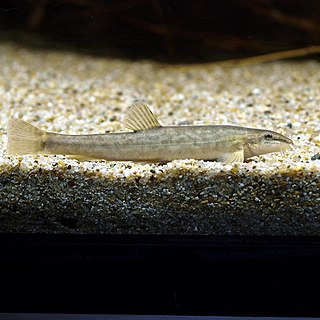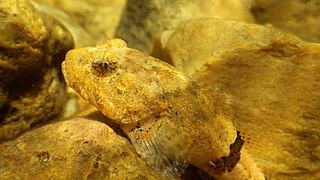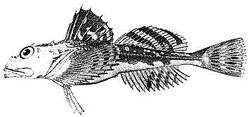
The Scorpaeniformes are a diverse order of ray-finned fish, including the well-known lionfish, but have also been called the Scleroparei. It is one of the five largest orders of bony fishes by number of species with over 1,320.

The Liparidae, commonly known as snailfish or sea snails, are a family of scorpaeniform marine fishes.

Rasbora is a genus of fish in the family Cyprinidae. They are native to freshwater habitats in South and Southeast Asia, as well as southeast China. A single species, R. gerlachi, is only known from an old specimen that reputedly originated from Africa (Cameroon), but this locality is considered doubtful. They are small, up to 17 cm (6.7 in) long, although most species do not surpass 10 cm (4 in) and many have a dark vertical stripe.

The mottled sculpin is a freshwater sculpin found widely although unevenly throughout North America.

The European bullhead is a freshwater fish that is widely distributed in Europe, mainly in rivers. It is a member of the family Cottidae, a type of sculpin. It is also known as the miller's thumb, freshwater sculpin, common bullhead and European bullhead.

Barbatula is a genus of fish in the family Nemacheilidae native to Europe and Asia. They are found in streams, rivers and lakes, and the genus also includes Europe's only cavefish, which only was discovered in the Danube–Aachtopf system in Germany in 2015.

Cobitis is a genus of small freshwater fish in the family Cobitidae from temperate and subtropical Eurasia. It contains the "typical spiny loaches", including the well-known spined loach of Europe. Similar spiny loaches, occurring generally south of the range of Cobitis, are nowadays separated in Sabanejewia.

Gobio is a genus of typical gudgeons, ray-finned fish in the family Cyprinidae many of which are endemics of south-eastern Europe. Members of the genus are usually small fish, rarely longer than 10 cm.

Schistura is a genus of fish in the stone loach family Nemacheilidae native to the streams and rivers of the southern and eastern Asia. Some of these species are troglobitic.
Squalius is a genus of fish in the family Cyprinidae found in Europe and Asia. Hybridization is not rare in the Cyprinidae, including this genus. S. alburnoides is known to be of ancient hybrid origin, with the paternal lineage deriving from a prehistoric species related to Anaecypris; the latter mated with ancestral S. pyrenaicus. Present-day S. alburnoides mates with sympatric congeners of other species.

The alpine bullhead or Siberian bullhead is a species of freshwater fish in the family Cottidae of sculpins. It is found in Belarus, China, the Czech Republic, Denmark, Estonia, Finland, Germany, North Korea, Latvia, Lithuania, Moldova, Norway, Poland, Romania, Russia, Slovakia, Slovenia, Sweden, and Ukraine. This fish is listed as being of "Least Concern" by the IUCN.

Cavefish or cave fish is a generic term for fresh and brackish water fish adapted to life in caves and other underground habitats. Related terms are subterranean fish, troglomorphic fish, troglobitic fish, stygobitic fish, phreatic fish and hypogean fish.

The banded sculpin is a freshwater fish dwelling mostly in small to moderate sized streams in areas of swift current. Young and juvenile C. carolinae can mainly be found in pools, riffles, and other shallow habitats while adults tend to prefer deeper waters. Mating and nesting for the sculpin is in spring, with males carefully guarding the eggs until they hatch.
The Nemacheilidae, or stone loaches, are a family of cypriniform fishes that inhabit stream environments, mostly in Eurasia, with one genus, Afronemacheilus found in Africa. The family includes about 630 species.

Icelinus is a genus of sculpins native to the Pacific Ocean.

The Blue Ridge sculpin is a species of sculpin in the family Cottidae. It is native to the eastern United States, where it can be found in a number of river systems that drain into the Atlantic.
The Cedar sculpin is a small, large-headed species of cottid that is found in the Coeur d'Alene and St. Joe rivers in northern Idaho, and in a stretch of the Clark Fork river in western Montana.

The Apogoninae are the most species-rich and, of its shape, size, color and habitat, most diverse subfamily of cardinalfishes (Apogonidae). It can be found in coastal tropical and subtropical regions of the Indian Ocean, the eastern Pacific and the Atlantic, down to depths of 300 meters.

Cottus rondeleti is a species of freshwater cottid fish that is only found in the coastal Hérault drainage of Southern France. The total known distribution comprises three distinct short stretches of stream, and the species considered critically endangered because of threat of drought that is promoted by water extraction and potentially by climate change.
The grotto sculpin is a species of fish in the family Cottidae. It is found in the United States where it only inhabits the Bois Brule drainage in Perry County of southeastern Missouri. It reaches a maximum standard length of 10.3 cm (4.1 in). This cavefish lives in underground streams and their resurgences. It was formerly confused with the more widespread C. carolinae, but can be separated by its smaller eyes and various degrees of reduced pigmentation. It is one of only three known cases of troglomorphism in the sculpin family, the others also involving U.S. Cottus.




















